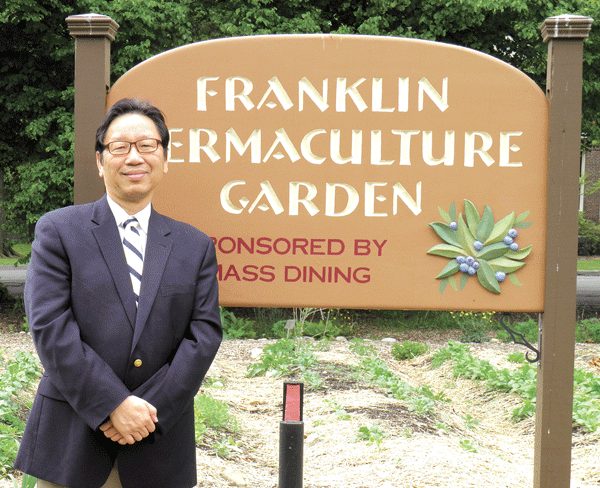Cooking Up Sustainability
By Kailey Houle
UMass Amherst Dining is serving up a new dish. Sort of. It’s called sustainability.
The dining program, long ranked among the best in the country, if not the best, is adding a focus on foods and their carbon footprint to what has been a steady diet of information provided to students about how to make smart choices about what to eat each day.

Ken Toong says that by serving more plant-based dishes, UMass Dining is helping students on campus reduce their carbon footprint.
UMass Amherst Dining is teaming up with MyEmissions, a food carbon-label company, to bring a sustainability factor to the table, an initiative that could be considered part of a broader, campus-wide focus on carbon footprints — and how to reduce them.
Indeed, in April, UMass Amherst Chancellor Kumble Subbaswamy proposed a plan to be a net-carbon zero university by 2032. And a survey of UMass students conducted this spring shows 75% believing their food choices impact the environment, and 76% believing it is important to reduce their carbon footprint. But they didn’t know where to begin.
“We started incorporating kelp on the menu — talk about a superfood; it’s a carbon sink, meaning it puts carbon back into the atmosphere. We partnered with a group in Maine that works with off-season lobstermen to grow kelp, and it’s going really well. We’ve done research and development on it, and again, we’re educating students that not only is kelp a superfood for your health, but it’s also a climate superfood.”
Low-carbon dining — an experience UMass is striving to perfect — refers to making food choices that have low greenhouse gas emissions associated with their life cycle. Examples of low-carbon foods include nuts, soy products, local vegetables, and dairy alternatives; high- carbon foods include beef, lamb, cheese, chocolate, and coffee. To combat higher emissions UMass sources its high carbon foods locally, and all of the low-carbon foods offered are grown locally and, in some cases, on campus.
“My team and I researched the issue and we have partnered with MyEmissions,” said Kathy Wicks, director of Sustainability at UMass Amherst. “They analyze each recipe for its carbon footprint. So we export our recipe, they analyze it, and then they send it back to us so we can put it on the menu identifiers and on the app.”
Elaborating, Wicks said that such analysis involves giving a rating — A through E, with A being the highest, or best grade — to each individual recipe based on its carbon footprint. A carbon footprint, as it relates to food, is the amount of carbon emissions, methane, or carbon dioxide involved in the food’s production. It takes into account the life cycle of whatever one is measuring, its land use, processing, transportation, and packaging. UMass has been able to reduce some of its carbon emissions already by partnering with local farmers and facilities to feed their students.
MyEmissions has worked with European restaurants to help them reduce their carbon footprint, but UMass Amherst Dining is the first university program in the country to be introducing an initiative like this. And as an anchor institution in the region and a recognized leader and innovator among dining programs, UMass is looking to tell a story others will follow.
“Yeah it’s delightful that we did it first, but it’s a better feeling knowing we can help our students make a better choice,” said Ken Toong, executive director of Auxiliary Enterprises at UMass Amherst, which oversees the dining program. “Food matters and I think this is an important thing for the UMass community.”
Wicks agreed, and noted that through this new initiative, the university hopes to better inform students about foods and their impact on the planet and perhaps inspire them to consider options — like kelp.
“We started incorporating kelp on the menu — talk about a superfood; it’s a carbon sink, meaning it puts carbon back into the atmosphere,” she explained. “We partnered with a group in Maine that works with off-season lobstermen to grow kelp, and it’s going really well. We’ve done research and development on it, and again, we’re educating students that not only is kelp a superfood for your health, but it’s also a climate superfood.”
Overall, plant-forward dining, and that includes kelp, helps to reduce the overall carbon footprint. Low-carbon foods are able to be grown, prepared, sourced, processed, and transported in ways that emit minimal greenhouse gas into the atmosphere. Food production in the United States makes up 20% of overall greenhouse gasses and globally it’s about 30%. UMass Dining works with local fair-trade-certified farmers and rely on permaculture gardens to source their meals.

Kathy Wicks says educating students on their food choices gives them the ability to take action to help the planet.
“We’ve been working with our local partners for a long time, we also work closely with companies around their practices and how they relate to sustainability,” Wicks said. “And this is a way we can help students practice everyday climate action with every food choice that they make.”
Wicks and others we spoke with stressed repeatedly that they are not trying to tell students what to eat. Rather, they are providing information that will help them make smart choices about what they might want to eat — information that goes beyond calories and ingredients and dives into a food’s overall impact on the planet
“We play a role in educating them on food literacy, but we also love to talk about food,” said Wicks. “We added this to the conversation because it is top of mind for so many people and the campus community as a whole.”
Carbon-use identifiers will be added to each menu, along with previous identifiers for allergies, ingredients, sustainability, plant-based, and locality.
“We have a very comprehensive menu system — we have identifiers for allergies, ingredients, and now they can assess it through the apps or on signs,” said Toong. “We just add it on the carbon calculator and put the rating on the menu.”
Toong said the Amherst campus is perhaps more diverse than ever, with many students, including those who are Asian, Latin, and Indian students seeking authentic cuisine that is mostly plant-based. More than 70% of the school’s menu items are already plant based, catering to vegetarians, vegans, and those with a more plant-driven diet.
“We’ve been working with our local partners for a long time, we also work closely with companies around their practices and how they relate to sustainability. And this is a way we can help students practice everyday climate action with every food choice that they make.”
“We know that plant-forward meals are going to be a trend; there is still meat, but smaller portions,” said Toong. “We only give three-to four-ounce red meat portions, and same thing with chicken. We’re selling more seafood and more plant-based dishes. This has really helped us make the decision to start the program.
“We’re not saying ‘don’t eat red meat,’ — we’re just suggesting smaller portion sizes,” he went on. “We don’t tell them what to eat — we provide them with information. But we want to promote more than just food, we want to promote culture and cuisine. Our goal is to work with students and the community to try to make the world a better place. We can do it by working together.”
Those we spoke with said the partnership with MyEmissions is merely another step in efforts to promote sustainability. They stressed the need to back up the information being provided with conversation about how to make smart choices.
“We’re not just going to put the information up there — we’re going to continue dialogue with our students about it and show them and give them tips that low-carbon dining is as easy as A, B, C,” said Wicks. “We’ve been dedicated to healthy, sustainable, delicious food for a long time. We always want to do more to enhance the student experience.
“We listen closely to what the students have to say,” she went on. “We listen closely to what they’re concerned about and what they are interested in and what their values are… the entire campus’ sustainability and the current issues with climate change are at the top of mind for everybody. So our expertise is food and customer service — that’s the area we want to do more. We know it has an impact on our environment.”
By making simple changes like trying out some new A-Rated dishes, anyone can help lower the carbon footprint — and those at UMass Dining know small changes like that can make a huge difference.









